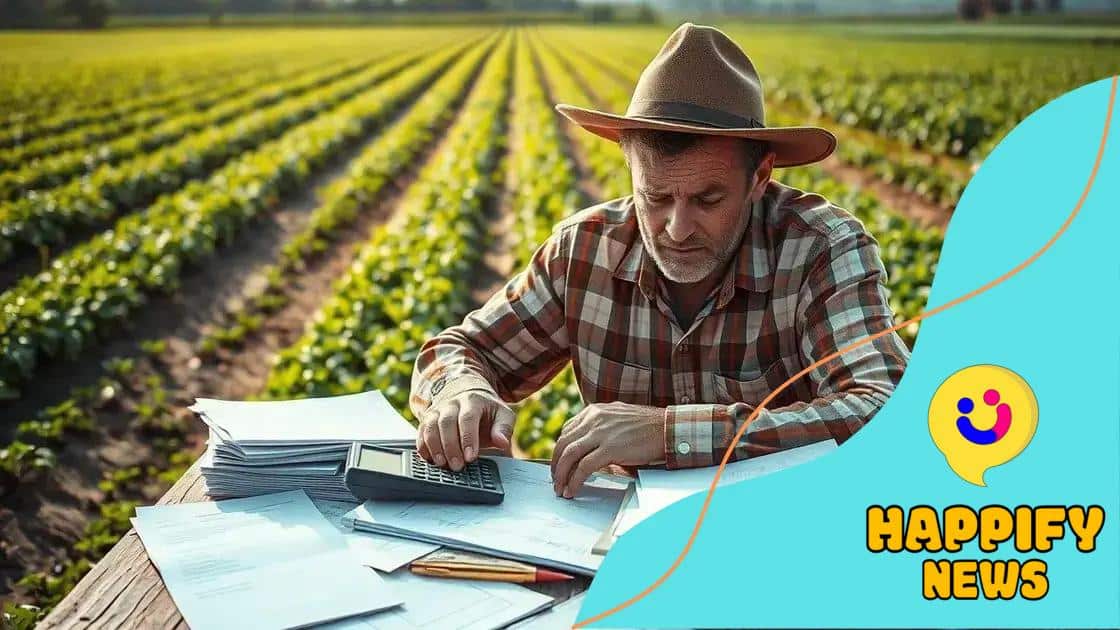Green agriculture investments: paving the way for sustainability

Anúncios
Green agriculture investments focus on sustainable farming practices that enhance productivity, protect the environment, and leverage innovative technologies for improved resource management and financial benefits.
Green agriculture investments are transforming the farming landscape, making it more sustainable and efficient. Have you ever wondered how these investments can lead to a healthier planet? In this article, we’ll explore their significance and impact on agriculture.
Anúncios
Understanding green agriculture investments
Understanding green agriculture investments is essential for farmers and investors who wish to contribute to a sustainable future. These investments focus on practices that protect the environment while ensuring profitability. They include funding for renewable energy in farms, organic farming methods, and advanced irrigation systems that save water.
Benefits of green agriculture investments
There are numerous benefits to adopting green agriculture investments. They not only enhance productivity but also create a positive impact on the ecosystem. Let’s look at some key benefits:
- Improved soil health, leading to better crop yields.
- Reduction in chemical usage, promoting biodiversity.
- Access to new markets focused on sustainable products.
Moreover, these investments can help mitigate the effects of climate change. When farmers invest in sustainable practices, they often find that they are more resilient against extreme weather events. For example, the adoption of cover crops can protect soil during heavy rains and droughts.
Anúncios
Challenges in green agriculture investments
Despite the benefits, there are challenges in green agriculture investments that must be addressed. The initial costs may deter some farmers. Developing countries often lack access to capital, making it difficult to invest in the technologies that support sustainable practices. Additionally, there is sometimes insufficient knowledge about the best practices to implement.
Collaboration between farmers, governments, and investors is crucial. By working together, they can share resources and knowledge that will aid in overcoming these barriers. Education and training programs are essential in helping farmers transition to these sustainable practices effectively.
In summary, understanding green agriculture investments empowers stakeholders to make informed decisions. As awareness grows, we can foster a farming future that’s both sustainable and profitable.
Benefits of green investments for farmers
The benefits of green investments for farmers are numerous and impactful. By adopting sustainable practices, farmers not only contribute to the environment but also enhance their own productivity and profitability. These investments often lead to healthier crops and livestock, resulting in higher-quality products.
Financial Gains from Sustainable Practices
Investing in green technologies can offer significant financial gains. Farmers who utilize renewable energy resources often see a reduction in operational costs. Moreover, they can access subsidies and grants aimed at promoting sustainability.
- Reduced energy costs through solar panels.
- Access to government incentives for sustainable farming.
- Increased market opportunities for eco-friendly products.
In addition to direct financial benefits, green investments can lead to long-term savings. For instance, using efficient irrigation techniques reduces water usage, leading to lower utility bills.
Environmental Benefits
Another important aspect is the environmental impact of green investments. By using less harmful chemicals and opting for organic methods, farmers improve soil health and foster biodiversity. This not only enhances crop yields but also contributes to a more resilient ecosystem.
Adopting these practices helps in capturing carbon in the soil, thus fighting climate change. Farmers can create habitats for wildlife by maintaining hedgerows and cover crops, which can also provide natural pest control.
Furthermore, consumers are increasingly seeking sustainable products. This trend provides farmers with the opportunity to market their goods as environmentally friendly, leading to higher prices and better sales.
The shift towards green investments signifies a broader movement towards sustainability in agriculture. By recognizing the numerous benefits, farmers can embrace these changes and secure their livelihoods while acting as stewards of the environment.
Challenges faced in green agricultural financing

Challenges faced in green agricultural financing can hinder the growth and implementation of sustainable practices among farmers. Understanding these challenges is crucial for both stakeholders and investors looking to promote eco-friendly initiatives in agriculture.
Access to Capital
One of the primary challenges is the limited access to capital for farmers. Many producers, especially in developing regions, struggle to secure the necessary funding to invest in sustainable technologies. This lack of financial resources prevents them from modernizing their operations and adopting green practices.
- High initial costs for sustainable equipment.
- Lack of financial institutions offering favorable terms.
- Inadequate financial literacy among farmers.
Obtaining loans or grants designed for green projects can be complicated. Farmers may need to navigate strict eligibility criteria and paperwork, which can deter them from applying.
Knowledge and Training Gaps
Another significant challenge is the gap in knowledge regarding sustainable practices and technologies. Farmers may not be aware of the benefits or methods to implement green agricultural practices. This issue is especially prevalent in areas with less access to education and training programs.
Investors and organizations can help bridge this gap by providing education and support. Workshops and training sessions can empower farmers with the skills needed to make informed decisions about their farming practices.
Furthermore, integrating traditional farming knowledge with modern sustainable techniques is key. By doing so, farmers can create unique solutions tailored to their specific circumstances.
Market Demand Fluctuations
Market demand is another challenge facing green agricultural financing. Farmers might invest heavily in sustainable methods, but if market demand for organic or sustainable products drops, their financial viability is threatened. Balancing supply and demand can be tricky, especially in fluctuating markets.
Investors must be aware of these risks and consider diversifying their portfolios to include different types of sustainable farming projects. This approach can stabilize income and mitigate losses should market conditions change.
In summary, while challenges exist in green agricultural financing, addressing these issues through collaboration, education, and innovative solutions can empower farmers to adopt more sustainable practices.
Innovative practices in sustainable farming
Innovative practices in sustainable farming are reshaping agriculture. Farmers are increasingly adopting new techniques that not only improve yields but also protect the environment. These practices contribute to long-term sustainability and enhance food security.
Crop Rotation
One effective practice is crop rotation. This method involves alternating the types of crops grown in a particular area each season. By doing so, farmers can improve soil health, reduce pests, and enhance biodiversity.
- Helps prevent soil depletion by restoring nutrients.
- Breaking pest cycles, leading to healthier crops.
- Encourages a diverse ecosystem on the farm.
Farmers who implement crop rotation often report better yields and reduced need for chemical fertilizers, making it both economical and environmentally friendly.
Agroforestry
Agroforestry is another innovative practice where trees are integrated into crop and animal farming systems. This approach maximizes the benefits of land use and can lead to increased biodiversity.
In addition, agroforestry provides shade for crops, helping to conserve water and reduce temperature extremes. Farmers practicing agroforestry can also see improved soil structure and fertility.
By creating habitats for various species, agroforestry contributes to maintaining a balanced ecosystem, which is essential for sustainable farming.
Precision Agriculture
Utilizing technology is central to precision agriculture. This innovative approach involves using data to optimize field-level management. Farmers can use sensors, drones, and satellite imagery to monitor crop health and soil conditions.
- Allows for targeted application of water and fertilizers.
- Reduces waste and saves resources.
- Enhances productivity while minimizing environmental impact.
These technologies empower farmers to make informed decisions, directly contributing to sustainability and efficiency in their operations.
As the world faces increasing environmental challenges, adopting such innovative practices can help farmers not only sustain their livelihoods but also contribute to a healthier planet. Embracing these methods is crucial for the future of agriculture, ensuring we meet the needs of a growing population while respecting our natural resources.
Future trends in green agriculture investments
Future trends in green agriculture investments indicate a significant shift towards more sustainable and eco-friendly practices. As environmental concerns grow, farmers and investors are increasingly looking for innovative solutions that benefit the planet and improve agricultural productivity simultaneously.
Increased Use of Technology
One of the main trends is the integration of technology into sustainable farming. Technologies such as precision agriculture, drones, and IoT (Internet of Things) devices are becoming more popular. These tools help farmers monitor crops effectively and manage resources efficiently.
- Real-time data collection on soil health and moisture levels.
- Automated systems for irrigation and fertilization.
- Enhanced crop monitoring through aerial imaging.
This technology allows farmers to make more informed decisions, which can lead to reduced costs and increased yields. As technology advances, we can expect even more innovative solutions that make farming more sustainable.
Investment in Renewable Energy
Another trend is the growing investment in renewable energy sources within agriculture. Farmers are increasingly adopting solar panels and wind turbines to power their operations.
By harnessing renewable energy, farms can reduce their dependence on fossil fuels and lower their carbon footprint. This transition also leads to long-term savings on energy costs, making it a financially smart choice for farmers.
Focus on Regenerative Practices
Regenerative agriculture is gaining traction as a trend for the future. This approach goes beyond sustainability by actively improving soil health and increasing biodiversity. Farmers are exploring methods like cover cropping, no-till farming, and agroecology.
- Enhancing soil fertility and reducing erosion.
- Increasing carbon sequestration in the soil.
- Promoting a diverse ecosystem that benefits all farm species.
As consumer demand for organic and clean food rises, this method could become the standard rather than the exception. Investors are more likely to fund projects that focus on these regenerative practices, recognizing their role in tackling climate challenges.
With these evolving trends, the landscape of green agriculture investments is poised for substantial change. Stakeholders who adapt to these advancements will be well-positioned to succeed in an increasingly competitive market.
Conclusion: Green agriculture investments represent a vital shift towards sustainable farming that benefits both the environment and farmers. By embracing innovative practices, farmers can enhance productivity while protecting natural resources. As technology advances and market trends shift, these investments will likely become more accessible, fostering a greener future for agriculture. It is essential for stakeholders to stay informed and adapt to changes in the landscape of green investments. Together, we can cultivate a more sustainable world.
FAQ – Frequently Asked Questions about Green Agriculture Investments
What are green agriculture investments?
Green agriculture investments focus on sustainable farming practices that benefit both the environment and the economy.
How can technology improve sustainable farming?
Technologies like precision agriculture, drones, and IoT devices help farmers monitor crops and manage resources more efficiently.
What are the financial benefits of green investments?
Investing in green practices can lead to lower operational costs, access to subsidies, and increased market opportunities.
How can farmers overcome financing challenges?
Farmers can seek educational resources, connect with financial institutions that offer favorable terms, and explore government grants aimed at sustainable practices.






